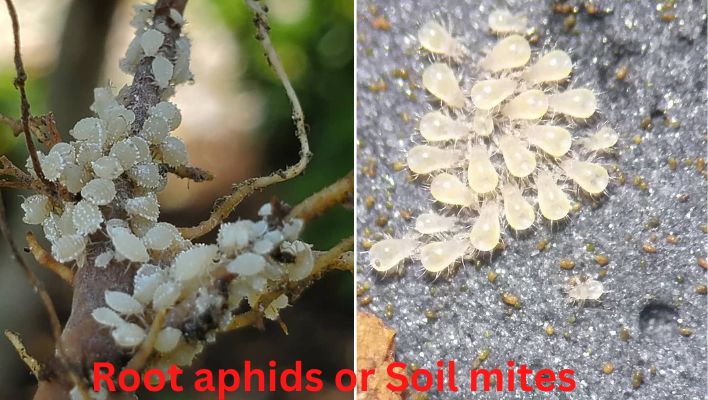Do you know if you’ve got root aphids or soil mites? Root aphids and soil mites are common pests in many gardens and nurseries, but they can be difficult to find and identify.
Soil mites or root aphids are small, soft-bodied insects that you might not have noticed. It’s easier than you think to confuse these two pests. Root aphids are small, oval-shaped, whitish, or yellowish bodies with orange legs that feed on roots, stems, and leaves.
While soil mites are tiny arthropods that live in the top layers of soil, they are considered pests when their activities affect crops or plants.
Root aphids and soil mites represent two different pests that tend to cause similar symptoms when left unchecked.
If you’re wondering if you have root aphids or soil mites, you’re not alone. These two pests are difficult to distinguish from each other.
However, there are some differences in appearance, behaviors, and life cycles between them (as well as a few unique characteristics that make them different from one another).
This article covers the most distinguishing features of each species, what these insects look like, and how they damage plants to help your decision on what to do.
What are root Aphids?
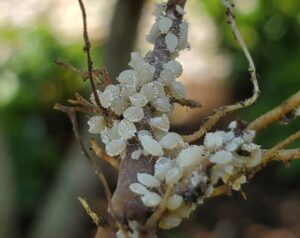
Root aphids are a type of aphids that live in the roots of plants. They are soft-bodied, whitish insects that can be seen on the soil’s surface. They are most commonly associated with weeds but can also be found in ornamentals and vegetables.
These insects live off of root hairs and feed on the sap in the roots of plants. They can harm the plant by reducing its vigor or causing it to become discolored, stunted, and reducing yield.
Root aphids often hide during the day in cracks in sidewalks or other structures near where they’re found. If they’re not controlled quickly, they can cause serious damage to plants.
They have wings but aren’t able to fly very well. Their larvae look like small white worms that live inside the root system of plants.
Because they’re so small, you may not realize you have root aphids until it’s too late. It’s best to get rid of them as soon as you spot them; otherwise, they’ll continue sucking out your plant’s nutrients, killing it from the inside out and reducing yields.
What Root Aphids Look Like
Root aphids are tiny, white bugs that look like tiny little grains. They’re typically found on the roots of plants, but they can also be found on stems and leaves.
Root aphids typically stay hidden in the soil or under the bark of trees. If you look closely at your plant, you might be able to see a small amount of white grub-like insects moving around your roots. They can be very small, about 1/10 of an inch long, but they’re also very common.
Most people don’t notice these pests until they start feeding on their plants’ roots (especially if there’s been a drought). That’s when you’ll notice your plant is thirsty and wilting, even though it hasn’t gotten any water.
What are soil mites
Soil mites are tiny arthropods that live in the soil. They can be a major threat to plant health but are also important to nature’s ecosystem. They are often mistaken for mites, but a soil mite is much smaller than a typical mite.
Soil mites are tiny bugs that live in the soil. They won’t harm plants, but they can be a problem if you’ve got an infestation. They can be an indicator of poor water quality.
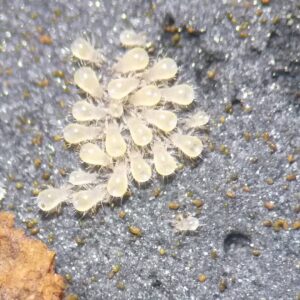
Soil mites are like your garden’s immune system; they’re in charge of keeping the environment free of harmful microbes and helping plants grow healthy. They’re an important part of the ecosystem and help keep other critters from thriving in your garden or farm.
They feed on bacteria and other microorganisms, which helps to break down organic matter, which is necessary for healthy plants. They also eat fungus spores, a big problem for gardeners who want to grow fungus-resistant plants. These nutrients are needed for plant survival.
Soil mites are harmless to humans and pets but can cause problems if they build up in large numbers. They can be really helpful by eating the fungus and bacteria that cause disease in your plants.
There are two types of soil mites: parasitic and nonparasitic. Parasitic soil mites live on plant roots and suck the nutrients out of them, which can cause leaf drop or death. Nonparasitic soil mites are not harmful, but they can still cause problems if they’re left unchecked. So if you find more than one soil mite per square foot of your garden, it’s time to take action.
What Soil Mites Look Like
Soil mites are tiny, microscopic arthropods found in the soil of grasslands and pastures. These tiny creatures are hard to see with the naked eye (which is why most people don’t know they exist).
They’re not harmful to humans or animals, but they can cause problems in the soil if they’re not controlled. They live in the top 4 inches of soil and use their long legs to move around. They appear when the soil temperature gets warm and thrive in moist conditions.
Root aphids or soil mites – How to Tell Soil Mites from Root Aphids
It’s hard to tell the difference between soil mites and root aphids. As a backyard gardener, you’re probably well versed in which insects are pests and which ones you can keep around for free food. But there’s more to identifying these two pests than knowing their appearances. Here are some tips for distinguishing them from each other so you won’t be tempted to treat the wrong one.
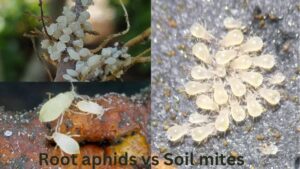
- Soil mites are tiny, brown insects found in your soil. They don’t cause any damage to plants, but they make the soil feel gritty and uncomfortable to work in. Root aphids are small orange or yellow bugs that feed on plant roots. They’re most commonly found on plant stems and roots.
- Root aphids and other types of aphids tend to feed on the roots of plants, while soil mites typically eat fungi or other biological material found in soil.
- Root aphids have a long, yellowish body and a white coating, while soil mites look like tiny spiders with eight legs.
- Soil mites are smaller than root aphids, ranging from 0.25 mm to 1 mm in length. The body of a root aphid range from 1 mm to 3 mm long.
- The body of a soil mite is rounded and smooth, and the legs are long and slender, while the body of root aphids is flat or slightly convex, with legs that may be short or long, depending on the species.
- The coloration of soil mites ranges from light yellow to dark brown; Root aphids have a lighter coloration—typically creamy white or yellowish-white, with darker markings on the head region (e.g., “velvet” covers for sucking sap).
- The soil mites have long, skinny heads, and the root aphids have small, round heads.
- Soil mites live in cracks between stones or soil particles and feed on soil particles to break down organic matter. Root aphids concealed under leaves or in cracks in your garden soil.
- Root aphids have short and thin antennae and may have two pairs of wings. Soil mites are insects with six pairs of legs and no wings
- Root aphids produce honeydew that attracts ants that help spread the aphids. Soil mites do not produce honeydew.
- Soil mites in small populations benefit your plant; root aphids are not.
- Soil mites are only found in soil. Root aphids infest both soil and plants
- Root aphids are mostly active during warm or high temperatures, while soil mites prefer dark areas with no direct sunlight.
- Root aphids are visible to the eyes, while soil mites are not. You may need a microscope to see soil mites.
How Soil Mites and Aphids Affect your Plants
Root aphids and other related insects are considered endoparasites because they live inside and off the plant. They do not cause direct damage to the plant, but they can cause problems if left unchecked.
The plant may grow slower than usual because it’s being fed by an external source of nutrition, which means there’s less available energy for flowering or other important functions like growing leaves or producing fruit.
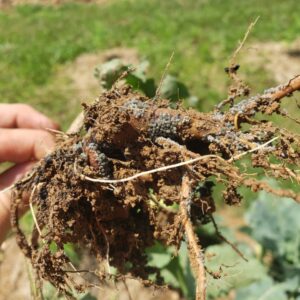
Soil mites also parasitize plants but don’t feed on their roots as root aphids do; instead, they eat fungi and bacteria in the soil. They are considered beneficial when their population is low and become pests when their activities affect the plants.
These pests feed on the roots of plants, especially in the winter. The symptoms of root aphids or soil mites include:
- Stunted growth
- black, white, or brownish roots.
- yellowed and dull-looking leaves
- Reduced flowering or fruit production
- Flowers developing abnormally small fruits
How to get rid of a root aphid and soil mites
Now you know the soil is not the problem in your garden; they still need to be controlled to put their population down; however, root aphids are and need to be treated to prevent further damage.
Aphids are perhaps the most annoying bug in your garden. They can be found on every type of plant, and they’ll suck the yummiest part of your plants dry.
Luckily, there are plenty of ways to eliminate root aphids and soil mites without harsh chemicals or pesticides. Here are some of our favorite remedies:
Apply Beneficial Nematodes
Nematodes are microscopic worms that feed on plant roots and are known for their ability to kill off many kinds of pests. They can be purchased at most garden centers or online.
Start by soaking the soil in your garden with a solution of water and Beneficial Nematodes (available at most garden centers). Soak your plants for 2-3 weeks, depending on the severity of the infestation.
After this time, check your plants regularly to see if any pests have reappeared. If they have, repeat the process until no new pests appear. If you see no sign of pests after three weeks, it’s safe to pull up your plants or try other methods below.
Use Neem Oil
Neem Oil is a great way to eliminate a root aphid or soil mite problem. You can use Neem Oil on your plants and in the soil around them. It kills plant pathogens that cause diseases in your plants, so it’s a great preventative measure for any disease or pest.
Neem oil also discourages insects from eating your plants, so this will help protect your plants. Neem oil is available in many different forms: as an oil and as a ready-to-use spray. You can also make your neem oil spray at home.
Mix one part Neem Oil with two parts water and pour it over your soil. Then keep the area damp for a week, and then you’re good to go. It is effective and non-toxic to humans and animals, so you don’t have to worry about getting sick or killing off other beneficial insects in your garden with too much exposure.
Horticultural oil
Horticultural oil is a concentrated oil that can be applied directly to the pests affected area of your lawn. It’s safe for humans and pets but should be applied only as directed by the manufacturer. Horticultural oil is made from plant extracts so that it won’t harm your lawn or garden plants.
The best time to apply horticultural oil is in the morning when the temperature is cooler, and there are fewer insects around. To apply horticultural oil:
- Mix 1/2 cup of horticultural oil with 1 cup of water in a spray bottle. You may also want to add some vitamin B12 solution or Epsom salts if your soil has been treated with fertilizer recently or if there are any other health concerns (e.g., iron deficiency).
- Spray the mixture onto the surface of your lawn where you see some aphids or mites present.
Drenching the soil
The easiest way to get rid of root aphids and soil mites is to drench the soil. The best time to do this is in the early morning before the sun has had a chance to dry out your plant’s roots. You can use a sprayer or an old paintbrush, or you can pour some water into the bottom of your pot.
If you’re using a sprayer, try spraying directly onto your plant’s root system; you want to ensure it gets everywhere. You can add neem oil to the water to help kill and repel pests in your garden. If you don’t have a sprayer, try standing up your pot and pouring water into it from the bottom.
Use insecticidal Soap
Another pest control method is insecticidal soap. These soaps kill insects by damaging their protective coating. Insecticidal soaps are made from a mixture of fatty acids, waxes, and surfactants that work to break down the waxy outer layer of insects’ bodies.
Together with water, these chemicals create a foam that can be applied to plants by drip irrigation or as a spray on foliage.
Insecticidal soap can kill root aphids, soil mites, mealybugs, and whiteflies, so it is an effective pesticide. It works by disrupting the insects’ nervous systems, which are made up of a series of nerve centers. This causes them to stop feeding and die.
Soap is most effective when applied in an area where the pest was spotted. Use an insecticidal soap solution to wash your plants’ leaves and stems. Then, wait 24 hours before watering again to allow the soap to dry completely.
Mix 1 tablespoon of insecticidal soap with 1 quart of water in a clean container or sprayer. If using a sprayer, fill it half full with water and then add 1/4 cup of insecticidal soap. Stir well to mix, then place the lid on the container until ready to use.
Use diatomaceous earth
Diatomaceous earth is a great option if you’re looking for a way to get rid of aphids and soil mites. It is a natural substance made up of tiny fossilized algae that kill insects.
It’s made of tiny skeletal fragments called diatoms, which are found in sedimentary rocks all over the world. When you put diatomaceous earth in your garden soil, it cuts through the outer layer of the insect’s exoskeleton, the layer that keeps it alive and kills it.
You can apply the powder directly to plants by sprinkling some into their soil or mixing it with water. You can also use an organic liquid diatomaceous earth sprayer to apply the powder evenly across large areas. Be careful not to let any get on your skin or clothes; this stuff is very abrasive.
Companion plants
Companion plants are plants that grow well together and help each other out. You can use companion planting to treat aphid infestations by planting different types of plants near your greenhouse or garden. Choose plants that are not susceptible to aphids, such as cacti and tomatoes. Planting these plants will protect your other plants from being attacked by aphids.
The best companion plants for helping to repel aphids are marigolds, mints, nasturtiums, and thyme. Marigolds attract beneficial insects and help keep them away from your tomato plants; mints will repel aphids; nasturtiums are often used in gardens because they attract hoverflies and other pollinators, and thyme is often used in gardens because it repels aphid infestations! Avoid using too much fertilizer.
Mulch
Another common method of controlling aphids is to apply mulch around your plants. Mulching helps keep weeds down and reduces water evaporation which helps with drought conditions like those experienced during an aphid infestation. It also keeps soil temperatures cooler, which prevents populations of harmful pests such as aphids from growing.
Destroy affected plants
After trying various methods and you still have aphids in your plant, then you will need to destroy the affected plants. The more plants you remove, the less chance the aphids can spread. This can be done by digging up the roots of each plant and destroying them.
You should also remove any plants in direct contact with your soil or those that may have come into contact with the affected plants. These include garden tools, pots, and other gardening equipment used during this period.
If you’ve removed all of these items, it’s time to dispose of the soil. You can pour it out in a large compost bin or bury it under a layer of leaves or straw.
Ways to prevent aphids from spreading:
- Don’t plant susceptible crops in the same area yearly (this is especially important for tomato and pepper plants).
- Keep your garden free of weeds and debris; these attract aphids.
- Do not use pesticides on your plants if you want them to be disease-resistant (see below).
- Make sure you have adequate nitrogen available in your soil (see below).
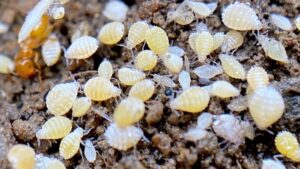
What kills aphids but not plants?
Aphids are a common problem for plants, but you can get rid of them without harming the plant. Many of the listed methods above will not harm your plants, and they can also be used to enhance the quality of your soil.
There are several ways to control aphids, but one of the easiest is to use insecticidal soap. Insecticidal soaps kill aphids and other soft-bodied insects on contact. They’re also very safe for most plants, as long as they aren’t sensitive to the active ingredient in your soap product.
If you’re unsure of the active ingredient in your soap product, test a small area of your plant before using it over the counter. You may also try soap spray or neem oil. Both methods work by interrupting an aphid’s life cycle, so they need to be reapplied periodically if you want to keep them under control.
Neem oil is derived from plants that grow in India and Africa, so it has been used for centuries by farmers there as well as home gardeners around the world who want to keep aphids away from their produce year-round without resorting to harsh chemicals like pesticides or insecticides (which can be harmful to humans and wildlife).
Alternatively, you can expose infested plants to sunlight; Aphids are great at surviving in a wide variety of environments but tend to be killed by very high temperatures. Aphids can survive in the sun for hours but cannot survive when their body temperature reaches above 115 degrees Fahrenheit. In order to kill aphids, you need to keep temperatures below that point.
